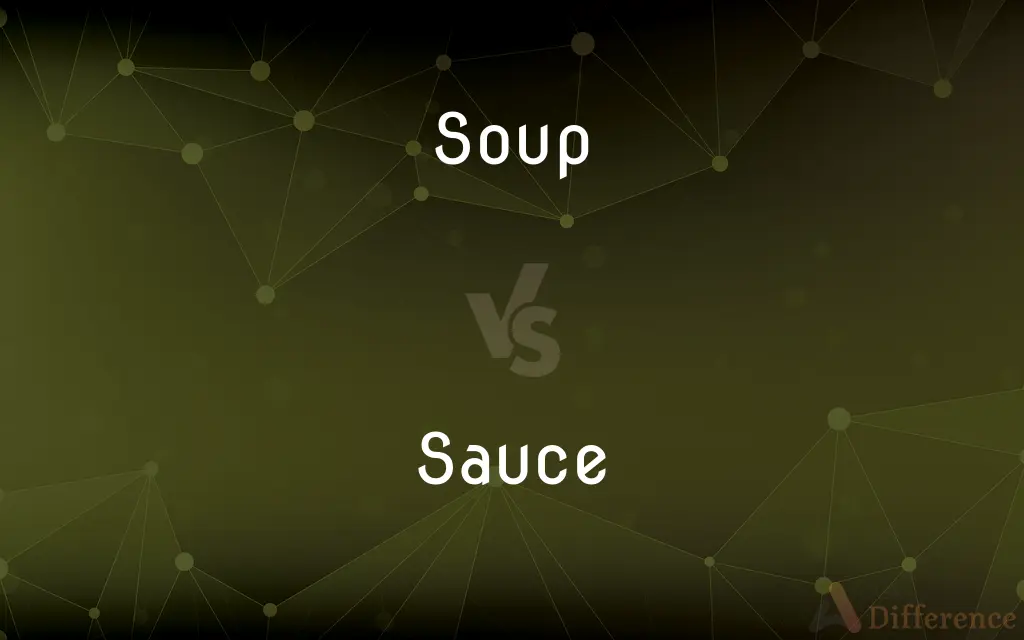Soup vs. Sauce — What's the Difference?
By Tayyaba Rehman & Urooj Arif — Updated on March 19, 2024
Soup is a liquid food often served hot, made by combining ingredients like meat, vegetables, and stock, while sauce is a thick, flavorful liquid used to enhance the taste of other dishes.

Difference Between Soup and Sauce
Table of Contents
ADVERTISEMENT
Key Differences
Soup is a versatile dish that can be served as a main or side, characterized by its liquid form and the combination of various ingredients such as meats, vegetables, and broths. Sauces, on the other hand, are primarily used to add flavor, moisture, and visual appeal to other dishes, ranging from thick and creamy to light and savory.
While soups can be enjoyed as a standalone meal, offering a range of textures and flavors depending on the ingredients and cooking method, sauces are not typically consumed on their own. Instead, they complement the flavors of the main dish, whether they are drizzled, dipped, or used as a cooking medium.
The preparation of soup often involves simmering ingredients to extract flavors and create a nutritious broth, which can be clear or thickened with ingredients like cream or roux. Conversely, sauces may involve a variety of techniques, including reduction, emulsification, or thickening with agents like starches or egg yolks.
Soup can be classified into categories such as broth-based, cream-based, or stew-like, each with distinct characteristics and serving methods. Sauce classifications, however, are based on their composition and use, such as dessert sauces, pasta sauces, or gravies, each designed to enhance a specific type of dish.
Cultural significance also distinguishes soups and sauces; soups are often central to meals and carry traditional and regional significance, reflecting local ingredients and culinary practices. Sauces, while also culturally significant, are more about enhancing or complementing the main components of a meal rather than serving as the focal point.
ADVERTISEMENT
Comparison Chart
Function
Served as a standalone dish or side
Used to add flavor, moisture, and visual appeal to dishes
Consistency
Ranges from light and brothy to thick and stew-like
Generally thicker, can be smooth or chunky
Consumption
Can be a complete meal
Not typically consumed alone
Preparation
Involves simmering ingredients
May involve techniques like reduction or emulsification
Varieties
Broth-based, cream-based, stew-like
Dessert sauces, pasta sauces, gravies
Compare with Definitions
Soup
Liquid Dish
Chicken noodle soup is a comforting dish made with chicken, noodles, and vegetables in a clear broth.
Sauce
Flavor Enhancer
Béarnaise sauce, made with clarified butter, egg yolks, and herbs, is often served with steak.
Soup
Variety of Ingredients
Minestrone soup combines vegetables, beans, pasta, and sometimes meat in a tomato-based broth.
Sauce
Dessert Component
Chocolate sauce is a popular topping for desserts like ice cream and cakes.
Soup
Nutritious Meal
Lentil soup provides a hearty and nutritious option, rich in protein and fiber.
Sauce
Thick Consistency
Alfredo sauce is a creamy blend of butter, heavy cream, and Parmesan cheese used in pasta dishes.
Soup
Served Hot or Cold
Gazpacho is a refreshing cold soup made from blended raw vegetables, ideal for hot weather.
Sauce
Culinary Staple
Soy sauce is an essential condiment in Asian cuisine, adding a salty, umami flavor to dishes.
Soup
Cultural Significance
Pho is a traditional Vietnamese soup consisting of broth, rice noodles, herbs, and meat.
Sauce
Diverse Uses
Tomato sauce serves as a base for numerous Italian dishes, from pasta to pizza.
Soup
Soup is a primarily liquid food, generally served warm or hot (but may be cool or cold), that is made by combining ingredients of meat or vegetables with stock, milk, or water. Hot soups are additionally characterized by boiling solid ingredients in liquids in a pot until the flavors are extracted, forming a broth.
Sauce
In cooking, a sauce is a liquid, cream, or semi-solid food, served on or used in preparing other foods. Most sauces are not normally consumed by themselves; they add flavor, moisture, and visual appeal to a dish.
Soup
A liquid food prepared from meat, fish, or vegetable stock combined with various other ingredients and often containing solid pieces.
Sauce
A flavorful liquid or semisolid condiment or mixture of ingredients served as a topping or other accompaniment to food.
Soup
Dense fog.
Sauce
Stewed fruit, usually served with other foods.
Soup
Nitroglycerine.
Sauce
Something that adds zest, flavor, or piquancy.
Soup
Primordial soup.
Sauce
(Informal) Impudent speech or behavior; impertinence or sauciness.
Soup
A chaotic or unfortunate situation.
Sauce
(Slang) Alcoholic liquor.
Soup
Any of various dishes commonly made by combining liquids, such as water or stock with other ingredients, such as meat and vegetables, that contribute flavor and texture.
Pho is a traditional Vietnamese soup.
Sauce
To season or flavor with sauce.
Soup
(countable) A serving of such a dish, typically in a bowl.
Sauce
To add piquancy or zest to.
Soup
(uncountable) The liquid part of such a dish; the broth.
Sauce
(Informal) To be impertinent or impudent to.
Soup
(figuratively) Any mixture or substance suggestive of soup consistency.
Sauce
A liquid (often thickened) condiment or accompaniment to food.
Apple sauce; mint sauce
Soup
(slang) Thick fog or cloud (also pea soup).
Sauce
Tomato sauce (similar to US tomato ketchup), as in:
[meat] pie and [tomato] sauce
Soup
Or gelignite, especially when used for safe-cracking.
Sauce
Alcohol, booze.
Maybe you should lay off the sauce.
Soup
(cant) dope (an illicit drug used for making horses run faster or to change their personality).
Sauce
(bodybuilding) Anabolic steroids.
Soup
(photography) Processing chemicals into which film is dipped, such as developer.
Sauce
(art) A soft crayon for use in stump drawing or in shading with the stump.
Soup
(biology) A liquid or gelatinous substrate, especially the mixture of organic compounds that is believed to have played a role in the origin of life on Earth.
Primordial soup
Sauce
(dated) Cheek; impertinence; backtalk; sass.
Soup
An unfortunate situation; trouble, problems (a fix, a mess); chaos.
Sauce
Vegetables.
Soup
(surfing) The foamy portion of a wave.
Sauce
Any garden vegetables eaten with meat.
Soup
Alternative form of sup
Sauce
To add sauce to; to season.
Soup
(uncommon) To feed: to provide with soup or a meal.
Sauce
To cause to relish anything, as if with a sauce; to tickle or gratify, as the palate; to please; to stimulate.
Soup
(photography) To develop (film) in a (chemical) developing solution.
Sauce
To make poignant; to give zest, flavour or interest to; to set off; to vary and render attractive.
Soup
(obsolete) To proselytize by feeding the impoverished as long as they listen to one's preaching.
Sauce
(colloquial) To treat with bitter, pert, or tart language; to be impudent or saucy to.
Soup
Alternative form of sup
Sauce
(slang) To send or hand over.
Soup
(obsolete) To sweep.
Sauce
A composition of condiments and appetizing ingredients eaten with food as a relish; especially, a dressing for meat or fish or for puddings; as, mint sauce; sweet sauce, etc.
High sauces and rich spices fetched from the Indies.
Soup
A liquid food of many kinds, usually made by boiling meat and vegetables, or either of them, in water, - commonly seasoned or flavored; strong broth.
Sauce
Any garden vegetables eaten with meat.
Roots, herbs, vine fruits, and salad flowers . . . they dish up various ways, and find them very delicious sauce to their meats, both roasted and boiled, fresh and salt.
Soup
To sup or swallow.
Sauce
Stewed or preserved fruit eaten with other food as a relish; as, apple sauce, cranberry sauce, etc.
Soup
To breathe out.
Sauce
Sauciness; impertinence.
Soup
To sweep. See Sweep, and Swoop.
Sauce
A soft crayon for use in stump drawing or in shading with the stump.
Soup
Liquid food especially of meat or fish or vegetable stock often containing pieces of solid food
Sauce
To accompany with something intended to give a higher relish; to supply with appetizing condiments; to season; to flavor.
Soup
Any composition having a consistency suggestive of soup
Sauce
To cause to relish anything, as if with a sauce; to tickle or gratify, as the palate; to please; to stimulate; hence, to cover, mingle, or dress, as if with sauce; to make an application to.
Earth, yield me roots;Who seeks for better of thee, sauce his palateWith thy most operant poison!
Soup
An unfortunate situation;
We're in the soup now
Sauce
To make poignant; to give zest, flavor or interest to; to set off; to vary and render attractive.
Then fell she to sauce her desires with threatenings.
Thou sayest his meat was sauced with thy upbraidings.
Soup
Dope (a racehorse)
Sauce
To treat with bitter, pert, or tart language; to be impudent or saucy to.
I'll sauce her with bitter words.
Sauce
Flavorful relish or dressing or topping served as an accompaniment to food
Sauce
Behave saucy or impudently towards
Sauce
Dress (food) with a relish
Sauce
Add zest or flavor to, make more interesting;
Sauce the roast
Common Curiosities
How does the preparation of soup and sauce differ?
Soup preparation often involves simmering to combine flavors, while sauce making can include techniques like reduction and emulsification.
Is there a clear distinction between soup and sauce?
Generally, soups are standalone dishes or sides, while sauces are meant to accompany other dishes, but some exceptions blur the lines.
How do storage requirements differ for soups and sauces?
Soups might be stored in larger quantities and typically require refrigeration or freezing, while sauces may have varied storage needs depending on their ingredients.
Are all sauces liquid?
Most sauces are liquid or semi-liquid, but their consistency can vary widely from thin to very thick.
Can sauces be served cold?
Yes, some sauces like vinaigrettes or certain dessert sauces are served cold.
How important are soups and sauces in culinary traditions?
Both are integral to culinary traditions worldwide, each adding distinct flavors and textures to meals.
Can soup be used as a sauce?
While not common, some thick soups or purees can serve as a sauce base for other dishes.
Can the same ingredients be used for soup and sauce?
Yes, similar ingredients can be used, but the preparation and final consistency will differ.
Are there any no-cook versions of soups or sauces?
Yes, some soups like gazpacho and sauces like pesto do not require cooking.
How do regional cuisines affect soup and sauce varieties?
Regional cuisines greatly influence the types of soups and sauces, reflecting local ingredients, tastes, and culinary techniques.
Is it possible to make a quick soup or sauce at home?
Yes, there are numerous quick and easy recipes for both soups and sauces suitable for home cooking.
How does one choose between making a soup or a sauce?
The choice depends on the meal being prepared; soups can serve as a main or side, while sauces are chosen to complement specific dishes.
Are soups or sauces more nutritious?
Nutrition can vary widely in both; it depends on the ingredients and preparation methods used.
Can vegan or vegetarian options exist for both soups and sauces?
Absolutely, there are many vegan and vegetarian recipes for both soups and sauces.
How do chefs use soups and sauces in fine dining?
In fine dining, soups might be crafted as exquisite starters, while sauces are used to enhance and complement the flavors of sophisticated dishes.
Share Your Discovery

Previous Comparison
Scope vs. Size
Next Comparison
Region vs. DistrictAuthor Spotlight
Written by
Tayyaba RehmanTayyaba Rehman is a distinguished writer, currently serving as a primary contributor to askdifference.com. As a researcher in semantics and etymology, Tayyaba's passion for the complexity of languages and their distinctions has found a perfect home on the platform. Tayyaba delves into the intricacies of language, distinguishing between commonly confused words and phrases, thereby providing clarity for readers worldwide.
Co-written by
Urooj ArifUrooj is a skilled content writer at Ask Difference, known for her exceptional ability to simplify complex topics into engaging and informative content. With a passion for research and a flair for clear, concise writing, she consistently delivers articles that resonate with our diverse audience.
















































